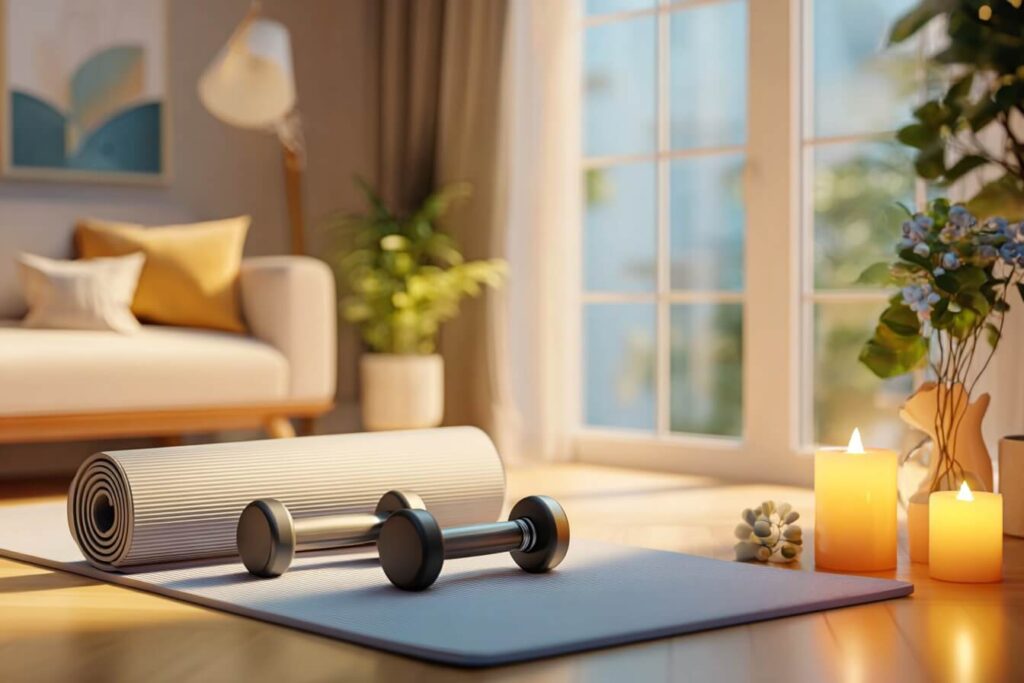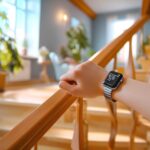In today’s urban environment, achieving the recommended 10,000 daily steps can feel impossible, especially when working from home, dealing with inclement weather, or living in areas with limited safe walking spaces. The rise of remote work and apartment living has made traditional step-counting strategies less accessible, leaving many people struggling to meet their daily movement goals.
However, reaching 10,000 steps doesn’t require outdoor adventures or gym memberships. With creative indoor walking strategies, smart home modifications, and strategic daily routines, you can easily achieve and exceed your step goals while enjoying the comfort and convenience of your own living space.
This comprehensive guide will transform your home into a fitness-friendly environment where accumulating steps becomes natural, enjoyable, and seamlessly integrated into your daily routine.
Contents of the article:
Understanding the 10,000 Step Goal
Creative Indoor Walking Strategies
Technology and Tools for Indoor Step Tracking
Daily Routine Integration Techniques
Motivation and Habit Building Strategies
Overcoming Common Indoor Walking Challenges
Health Benefits and Long-Term Success
Understanding the 10,000 Step Goal
Before diving into indoor walking strategies, it’s important to understand why 10,000 steps has become the gold standard for daily movement and how this goal can be adapted to home-based fitness routines.
The Science Behind Step Counting
The 10,000-step recommendation originates from Japanese research in the 1960s, but modern studies consistently support this target for maintaining cardiovascular health, weight management, and overall well-being. Walking 10,000 steps typically burns 300-500 calories and provides approximately 4-5 miles of movement throughout the day.
For sedentary adults, reaching 10,000 daily steps can significantly reduce risks of heart disease, diabetes, and mental health issues while improving sleep quality, bone density, and cognitive function.
Adapting Step Goals for Indoor Living
Indoor step counting may seem less natural than outdoor walking, but it offers unique advantages: climate control, safety, privacy, and the ability to multitask. Understanding how to maximize indoor movement helps you maintain consistent activity levels regardless of external circumstances.
Indoor walking also allows for more controlled pacing and the integration of household tasks, making it easier to accumulate steps throughout the day rather than trying to achieve the goal in a single walking session.
Creative Indoor Walking Strategies
Transforming your home into a step-accumulating environment requires creativity and strategic planning. These proven techniques help you naturally increase daily movement without feeling like you’re exercising.
The Home Walking Circuit
Create a designated walking route through your home that you can repeat multiple times throughout the day. Map out a circuit that flows naturally through different rooms, avoiding furniture and obstacles while maximizing distance.
A typical home circuit might include: living room to kitchen, around the dining table, down the hallway, through bedrooms, and back to the starting point. Time your circuit to understand how many laps equal specific step counts – this helps you plan walking sessions more effectively.
Vary your route occasionally to prevent boredom and engage different muscle groups. Consider creating both a longer circuit for dedicated walking time and a shorter loop for quick movement breaks.
Stair Climbing Maximization
If you have stairs in your home or apartment building, they become invaluable tools for rapid step accumulation. Stair climbing burns more calories per step than flat walking and provides excellent cardiovascular benefits.
Make multiple trips up and down stairs throughout the day instead of carrying everything at once. Use stairs for dedicated 5-10 minute walking sessions, focusing on steady, sustainable pacing rather than intense climbing.
For those without home stairs, consider investing in a step platform or using sturdy furniture (with proper safety precautions) to create step-up exercises that contribute to your daily count.
The Multitasking Walking Method
Integrate walking into activities you’re already doing to accumulate steps without adding extra time to your schedule. Walk in place while talking on the phone, pace during video calls (when cameras are off), or walk around your home while listening to podcasts or audiobooks.
This approach transforms normally sedentary activities into step-counting opportunities, making it easier to reach 10,000 steps without dedicating separate time for exercise.
Kitchen activities like cooking and cleaning provide excellent opportunities for extra movement. Walk in place while waiting for water to boil, pace while food cooks, or take extra steps by making multiple trips to put away groceries or dishes.
Room-by-Room Step Strategies
Each room in your home offers unique opportunities for step accumulation. Understanding how to maximize movement in different spaces helps you create a comprehensive indoor walking routine.
Living Room Fitness Zone
Transform your living room into a movement-friendly space by creating clear walking paths and incorporating step-friendly activities. Walk in place while watching television, pace during commercial breaks, or use entertainment time for leisurely indoor walks.

Consider rearranging furniture to create better walking spaces, or designate specific times when the living room becomes a walking area. Use area rugs to define walking paths and provide comfortable footing for extended indoor walking sessions.
Dancing to music, doing walking workouts via streaming fitness videos, or playing active video games can make living room movement more enjoyable while contributing significantly to daily step counts.
Kitchen Movement Hub
The kitchen naturally encourages movement through food preparation, cooking, and cleaning activities. Maximize these opportunities by taking extra steps during meal preparation and cleanup routines.
Walk in place while waiting for appliances to finish cycles, pace while coffee brews, or take extra trips between the refrigerator and counter. Use kitchen timers to remind yourself to walk in place during cooking breaks.
Organize kitchen storage to encourage more movement – place frequently used items in different locations so you naturally walk more while cooking and cleaning.
Bedroom Walking Routines
Use bedrooms for morning and evening walking routines that bookend your day with movement. Morning bedroom walks help wake up your body and mind, while evening walks can serve as relaxing, meditative movement before sleep.
Walk around your bedroom while getting dressed, choosing clothes, or organizing personal items. Use the space beside your bed for walking in place while watching morning or evening news.
Consider bedroom walking as part of your wind-down routine, replacing some screen time with gentle movement that contributes to both step goals and better sleep quality.
Hallway and Corridor Utilization
Long hallways and corridors provide excellent indoor walking opportunities, especially for achieving sustained walking periods. Use hallways for back-and-forth walking sessions, treating them like indoor walking tracks.
Time your hallway walks to understand distance and step counts, then use this knowledge to plan specific walking sessions. Hallway walking works well for phone calls, meditation walks, or dedicated exercise time.
If your home lacks long hallways, create walking paths that connect different rooms, using doorways and open spaces to maintain continuous movement flow.
Technology and Tools for Indoor Step Tracking
Leveraging technology effectively can make indoor step counting more accurate, motivating, and enjoyable while helping you optimize your home-based fitness routine.
Fitness Tracker Optimization
Modern fitness trackers and smartphone step counters work well for indoor walking, but understanding their limitations and strengths helps you use them more effectively. Most devices accurately count steps regardless of location, but may undercount certain activities like stair climbing or walking in place.
Wear your fitness tracker consistently and in the recommended position for optimal accuracy. Some devices allow you to manually add activities or adjust step counts for activities they might undercount.
Use tracker features like hourly movement reminders, step goals, and achievement badges to maintain motivation throughout the day. Many devices also track active minutes and calories burned, providing additional metrics for comprehensive fitness monitoring.
Step-Counting Apps and Programs
Smartphone apps can supplement wearable devices and provide additional motivation through social features, challenges, and detailed analytics. Popular apps like Google Fit, Apple Health, or Samsung Health integrate with other fitness tools and provide comprehensive activity tracking.
Look for apps that offer indoor walking programs, step challenges with friends or family, or integration with other health metrics. Some apps provide guided indoor walking workouts specifically designed for small spaces.
Use app notifications and reminders strategically – set them for times when you typically have lower activity levels to encourage movement throughout the day.
Home Fitness Equipment Integration
Consider investing in equipment that can boost your indoor step count and provide variety in your home fitness routine. Treadmills, elliptical machines, or stationary bikes with step-counting features can help you reach daily goals regardless of weather or external circumstances.

Mini steppers, balance boards, or portable pedal exercisers offer affordable options for increasing indoor movement without requiring significant space or investment.
Remember that equipment should supplement, not replace, the natural movement opportunities throughout your home. The goal is creating sustainable daily habits rather than relying solely on exercise sessions.
Daily Routine Integration Techniques
Successfully reaching 10,000 steps daily at home requires integrating movement into your existing routines rather than treating it as a separate task requiring additional time.
Morning Movement Rituals
Start each day with movement to establish momentum for reaching your step goal. Create a morning routine that includes walking while your coffee brews, pacing while checking the weather and news, or doing a brief indoor walking session as part of your wake-up process.
Morning movement helps activate your metabolism, improve mental clarity, and establish a positive tone for the day. Even 10-15 minutes of morning indoor walking can contribute 1,000-1,500 steps toward your daily goal.
Consider replacing some morning screen time with movement, or combine activities like listening to daily news or podcasts with indoor walking to maximize efficiency.
Workday Movement Breaks
For those working from home, integrating regular movement breaks throughout the workday is essential for both step counting and productivity. Use natural work breaks like conference calls, file downloads, or thinking time for indoor walking.
Set reminders to take 5-minute walking breaks every hour, using this time to walk around your home, climb stairs, or pace while reviewing work materials. These brief sessions add up quickly throughout an 8-hour workday.
Replace some traditional coffee or snack breaks with movement breaks, using the time to accumulate steps while also boosting energy and focus for continued work productivity.
Evening Step Completion
End your day by reaching your step goal through enjoyable evening activities. Use dinner preparation time for extra kitchen movement, take evening walks around your home while listening to music, or incorporate movement into your evening entertainment routine.
Evening step completion can serve as a transition between work and personal time, helping you mentally shift gears while contributing to your fitness goals. This approach makes reaching 10,000 steps feel like a natural part of your day rather than a chore.
Track your daily step count in the evening to understand how close you are to your goal, then use remaining evening time to complete any remaining steps through enjoyable activities.
Motivation and Habit Building Strategies
Maintaining consistent indoor step counting requires strong motivation and well-established habits that make the behavior automatic rather than dependent on daily willpower.
Setting Realistic Progressive Goals
Start with achievable step counts and gradually increase your daily goal to build confidence and establish sustainable habits. If you’re currently sedentary, begin with 5,000-6,000 daily steps before progressing to 10,000.
Track your baseline activity level for a week to understand your natural movement patterns, then add 500-1,000 steps weekly until you reach your target goal. This gradual approach prevents overwhelm and increases long-term success rates.
Celebrate milestone achievements and focus on consistency rather than perfection. Missing your goal occasionally is normal – the key is maintaining the habit over time rather than achieving perfect daily compliance.
Creating Environmental Cues
Modify your home environment to encourage more natural movement throughout the day. Place visual reminders like sticky notes near areas where you typically sit for long periods, encouraging brief walking breaks.
Keep comfortable walking shoes easily accessible, create clear walking paths through your home, and remove barriers that might discourage movement. Environmental design significantly impacts behavior change success.
Use existing habits as cues for movement – every time you go to the bathroom, take a brief walk around your home. When you finish a meal, walk around the kitchen or living room before sitting down again.
Social Accountability and Support
Share your step goals with family members, roommates, or online communities to create accountability and support for your indoor fitness routine. Having others aware of your goals increases motivation and provides encouragement during challenging days.
Consider step challenges with friends or family members, comparing daily counts and celebrating achievements together. Social competition and support significantly improve adherence to fitness goals.
Document your progress through photos, journal entries, or social media posts to create additional accountability while inspiring others who might face similar challenges with indoor fitness.
Overcoming Common Indoor Walking Challenges
Even with the best intentions and strategies, indoor step counting presents unique challenges that require specific solutions and mindset adjustments.
Dealing with Space Limitations
Small living spaces require creative solutions for accumulating steps, but size doesn’t have to prevent reaching your daily goal. Focus on maximizing movement within available space through walking in place, step-ups, and frequent short walking sessions.
Use vertical space through stair climbing or step platforms, and consider walking outside your apartment door in hallways or common areas when possible and appropriate.
Remember that step intensity and frequency can compensate for limited walking distance – shorter, more frequent walking sessions throughout the day can be just as effective as longer walks.
Maintaining Motivation in Repetitive Environments
Indoor walking can feel monotonous compared to outdoor walks with changing scenery. Combat boredom by varying your routes, listening to different music or podcasts, or incorporating different types of movement like dancing or marching in place.

Use entertainment strategically – save favorite podcasts or audiobooks for walking time, making indoor movement something you look forward to rather than endure.
Set variety goals like exploring different walking patterns, timing challenges, or integrating new movements to keep your indoor fitness routine engaging and fresh.
Weather and Seasonal Adjustments
Indoor step counting becomes especially valuable during extreme weather conditions, but seasonal changes can affect motivation and routine adherence. Prepare for seasonal challenges by establishing strong indoor routines before you need them.
During darker months, use indoor lighting effectively to maintain energy and motivation for movement. Consider vitamin D supplementation and light therapy to support overall energy levels that fuel consistent activity.
Treat indoor walking as your reliable fitness foundation that weather cannot disrupt, providing consistency and control over your daily activity levels regardless of external circumstances.
Health Benefits and Long-Term Success
Understanding the comprehensive health benefits of reaching 10,000 daily steps through indoor movement helps maintain long-term motivation and commitment to your home-based fitness routine.
Physical Health Improvements
Regular indoor walking provides the same cardiovascular benefits as outdoor walking, including improved heart health, better blood pressure control, and enhanced circulation. The controlled environment allows for consistent daily activity regardless of external factors.
Indoor step counting can improve balance, coordination, and muscle tone while providing low-impact exercise that’s gentle on joints. The ability to control pace and intensity makes it accessible for people of various fitness levels.
Weight management becomes more achievable when daily step goals are consistently met through indoor activity, as the routine becomes sustainable regardless of schedule changes or weather conditions.
Mental Health and Cognitive Benefits
Indoor walking provides significant mental health benefits including stress reduction, improved mood, and better cognitive function. The ability to combine movement with other activities like listening to music or podcasts can enhance these mental health benefits.
Regular movement throughout the day helps regulate energy levels, improve focus, and reduce the mental fatigue associated with sedentary work or lifestyle patterns.
The sense of accomplishment from consistently reaching step goals builds confidence and creates positive momentum that can extend to other areas of life and health.
Conclusion
Achieving 10,000 steps daily without leaving home is not only possible but can become an enjoyable, integral part of your daily routine. By transforming your living space into a movement-friendly environment, integrating walking into existing activities, and using technology strategically, you can maintain excellent fitness levels regardless of external circumstances.
The key to success lies in viewing indoor step counting as a lifestyle choice rather than a temporary exercise program. When movement becomes naturally integrated into your daily routines, reaching step goals feels effortless and sustainable.
Start with small changes, build gradually, and focus on consistency rather than perfection. Your home can become your most reliable fitness facility, providing year-round opportunities for health, wellness, and the satisfaction of achieving your daily movement goals. Remember that every step counts, whether taken during household chores, work breaks, or dedicated walking time. The cumulative effect of consistent indoor movement creates significant health benefits while proving that effective fitness solutions can be found right where you are.

